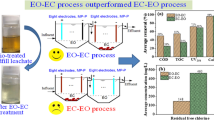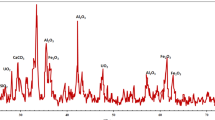Abstract
In this study, electrochemical processes, namely electro-oxidation (EO) and electro-Fenton (EF), using a boron-doped diamond (BDD) anode were introduced for high-strength brewery wastewater treatment. The emphasis of the work was focused on analyzing (i) performance of EO and integrated EO–EF processes in mineralizing organics from brewery wastewater, (ii) in-situ generation of H2O2 and ·OH radical, and (iii) contribution of the Fenton reaction in oxidizing organic content. The integrated EO–EF process, which involved external iron addition, showed a non-significant effect on treatment in comparison to the EO process. EO treatment alone (i.e., without any external iron dosing) demonstrated high removal of organic matter (∼ 91%). Pre-existing iron in brewery wastewater likely enhanced the EO treatment by incorporating in-situ electro-Fenton. The generation of H2O2 and ·OH exhibited variation due to the addition of iron from external sources. The predominant iron species found in the integrated EO–EF process was Fe(III), which can be attributed as an outcome of the Fenton reaction and the passivation of the electrode surface by iron complexes.
Graphical Abstract








Similar content being viewed by others
References
Doubla A, Laminsi S, Nzali S, Njoyim E, Kamsu-Kom J, Brisset JL (2007) Organic pollutants abatement and biodecontamination of brewery effluents by a non-thermal quenched plasma at atmospheric pressure. Chemosphere 69(2):332–337. https://doi.org/10.1016/j.chemosphere.2007.04.007
Valta K, Kosanovic T, Malamis D, Moustakas K, Loizidou M (2014) Overview of water usage and wastewater management in the food and beverage industry. Desalin Water Treat 53(12):3335–3347. https://doi.org/10.1080/19443994.2014.934100
Simate GS, Cluett J, Iyuke SE, Musapatika ET, Ndlovu S, Walubita LF, Alvarez AE (2011) The treatment of brewery wastewater for reuse: state of the art. Desalination 273(2–3):235–247. https://doi.org/10.1016/j.desal.2011.02.035
Parawira W, Kudita I, Nyandoroh MG, Zvauya R (2005) A study of industrial anaerobic treatment of opaque beer brewery wastewater in a tropical climate using a full-scale UASB reactor seeded with activated sludge. Process Biochem 40(2):593–599. https://doi.org/10.1016/j.procbio.2004.01.036
Simate GS, Iyuke SE, Ndlovu S, Heydenrych M (2012) The heterogeneous coagulation and flocculation of brewery wastewater using carbon nanotubes. Water Res 46(4):1185–1197. https://doi.org/10.1016/j.watres.2011.12.023
Wang SG, Liu XW, Gong WX, Gao BY, Zhang DH, Yu HQ (2007) Aerobic granulation with brewery wastewater in a sequencing batch reactor. Bioresour Technol 98(11):2142–2147. https://doi.org/10.1016/j.biortech.2006.08.018
Feng Y, Wang X, Logan BE, Lee H (2008) Brewery wastewater treatment using air-cathode microbial fuel cells. Appl Microbiol Biotechnol 78(5):873–880. https://doi.org/10.1007/s00253-008-1360-2
Singh KS, Viraraghavan T (2003) Impact of temperature on performance, microbiological, and hydrodynamic aspects of UASB reactors treating municipal wastewater. Water Sci Technol 48(6):211–217
Chen H, Chang S, Guo Q, Hong Y, Wu P (2016) Brewery wastewater treatment using an anaerobic membrane bioreactor. Biochem Eng J 105:321–331. https://doi.org/10.1016/j.bej.2015.10.006
Liao B-Q, Kraemer JT, Bagley DM (2006) Anaerobic membrane bioreactors: applications and research directions. Crit Rev Environ Sci Technol 36(6):489–530. https://doi.org/10.1080/10643380600678146
Krishnan Vijayaraghavan DA, Renny L (2006) Electrolytic treatment of beer brewery wastewater. Ind Eng Chem Res 45:6854–6859
Santana-Martínez G, Roa-Morales G, Martin del Campo E, Romero R, Frontana-Uribe BA, Natividad R (2016) Electro-Fenton and electro-Fenton-like with in situ electrogeneration of H2O2 and catalyst applied to 4-chlorophenol mineralization. Electrochim Acta 195:246–256. https://doi.org/10.1016/j.electacta.2016.02.093
Jardak K, Dirany A, Drogui P, El Khakani MA (2017) Statistical optimization of electrochemical oxidation of ethylene glycol using response surface methodology. Process Saf Environ Prot 105:12–20. https://doi.org/10.1016/j.psep.2016.08.021
Bakr AR, Rahaman MS (2016) Electrochemical efficacy of a carboxylated multiwalled carbon nanotube filter for the removal of ibuprofen from aqueous solutions under acidic conditions. Chemosphere 153:508–520. https://doi.org/10.1016/j.chemosphere.2016.03.078
Omi FR, Choudhury MR, Anwar N, Bakr AR, Rahaman MS (2017) Highly conductive ultrafiltration membrane via vacuum filtration assisted layer-by-layer deposition of functionalized carbon nanotubes. Ind Eng Chem Res 56(30):8474–8484. https://doi.org/10.1021/acs.iecr.7b00847
Zhang Y, Gao M, Wang S-G, Zhou W, Sang Y, Wang X-H (2017) Integrated electro-Fenton process enabled by a rotating Fe3O4/gas diffusion cathode for simultaneous generation and activation of H2O2. Electrochim Acta 231:694–704. https://doi.org/10.1016/j.electacta.2017.02.091
Barrera-Díaz C, Cañizares P, Fernández FJ, Natividad R, Rodrigo MA (2014) Electrochemical advanced oxidation processes: an overview of the current applications to actual industrial effluents. J Mex Chem Soc 58(3):256–275
El-Ghenymy A, Rodriguez RM, Brillas E, Oturan N, Oturan MA (2014) Electro-Fenton degradation of the antibiotic sulfanilamide with Pt/carbon-felt and BDD/carbon-felt cells. Kinetics, reaction intermediates, and toxicity assessment. Environ Sci Pollut Res 21(14):8368–8378. https://doi.org/10.1007/s11356-014-2773-3
Jiang C-c, Zhang J-f (2007) Progress and prospect in electro-Fenton process for wastewater treatment. J Zhejiang Univ Sci A 8(7):1118–1125. https://doi.org/10.1631/jzus.2007.A1118
Ganzenko O, Oturan N, Huguenot D, van Hullebusch ED, Esposito G, Oturan MA (2015) Removal of psychoactive pharmaceutical caffeine from water by electro-Fenton process using BDD anode: effects of operating parameters on removal efficiency. Sep Purif Technol 156:987–995. https://doi.org/10.1016/j.seppur.2015.09.055
Bensalah N, Bedoui A, Chellam S, Abdel-Wahab A (2013) Electro-Fenton treatment of photographic processing wastewater. Clean Soil Air Water 41(7):635–644. https://doi.org/10.1002/clen.201200521
Guinea E, Arias C, Cabot PL, Garrido JA, Rodriguez RM, Centellas F, Brillas E (2008) Mineralization of salicylic acid in acidic aqueous medium by electrochemical advanced oxidation processes using platinum and boron-doped diamond as anode and cathodically generated hydrogen peroxide. Water Res 42(1–2):499–511. https://doi.org/10.1016/j.watres.2007.07.046
Liu Y, Xie J, Ong CN, Vecitis CD, Zhou Z (2015) Electrochemical wastewater treatment with carbon nanotube filters coupled with in situ generated H2O2. Environ Sci Water Res Technol 1(6):769–778. https://doi.org/10.1039/c5ew00128e
Abdessamad N, Akrout H, Hamdaoui G, Elghniji K, Ksibi M, Bousselmi L (2013) Evaluation of the efficiency of monopolar and bipolar BDD electrodes for electrochemical oxidation of anthraquinone textile synthetic effluent for reuse. Chemosphere 93(7):1309–1316. https://doi.org/10.1016/j.chemosphere.2013.07.011
Wang CT, Hu JL, Chou WL, Kuo YM (2008) Removal of color from real dyeing wastewater by electro-Fenton technology using a three-dimensional graphite cathode. J Hazard Mater 152(2):601–606. https://doi.org/10.1016/j.jhazmat.2007.07.023
HACH (2012) Water analysis handbook, 7th edn. HACH Company, Loveland
Lacan F, Radic A, Jeandel C, Poitrasson F, Sarthou G, Pradoux C, Freydier R (2008) Measurement of the isotopic composition of dissolved iron in the open ocean. Geophys Res Lett. https://doi.org/10.1029/2008gl035841
Spolaor A, Vallelonga P, Gabrieli J, Cozzi G, Boutron C, Barbante C (2012) Determination of Fe2+ and Fe3+ species by FIA-CRC-ICP-MS in Antarctic ice samples. J Anal At Spectrom 27(2):310–317. https://doi.org/10.1039/c1ja10276a
Bader H, Sturzenegger V, Hoigne J (1988) Photometric method for the determination of low concentrations of hydrogen peroxide by the peroxidase catalyzed oxidation of N,N-diethyl-p-phenylenediamine (DPD). Water Res 22(9):1109–1115
Hsieh H-S, Jafvert CT (2015) Reactive oxygen species generation and dispersant-dependent electron transfer through single-walled carbon nanotubes in water. Carbon 89:361–371. https://doi.org/10.1016/j.carbon.2015.03.052
Fan Z, Kwon Y-H, Yang X, Xu W, Wu Z (2017) In-situ production of hydrogen peroxide as oxidant for direct urea fuel cell. Energy Procedia 105:1858–1863. https://doi.org/10.1016/j.egypro.2017.03.544
Peralta E, Roa G, Hernandez-Servin JA, Romero R, Balderas P, Natividad R (2014) Hydroxyl radicals quantification by UV spectrophotometry. Electrochim Acta 129:137–141. https://doi.org/10.1016/j.electacta.2014.02.047
Bard AJ, Faulkner LR (2001) Electrochemical methods fundamentals and applications, 2 edn. Wiley, New York
Terrazas E, Vazquez A, Briones R, Lazaro I, Rodriguez I (2010) EC treatment for reuse of tissue paper wastewater: aspects that affect energy consumption. J Hazard Mater 181(1–3):809–816. https://doi.org/10.1016/j.jhazmat.2010.05.086
Li H, Yu Q, Yang B, Li Z, Lei L (2014) Electrochemical treatment of artificial humidity condensate by large-scale boron doped diamond electrode. Sep Purif Technol 138:13–20. https://doi.org/10.1016/j.seppur.2014.10.004
Lan Y, Coetsier C, Causserand C, Groenen Serrano K (2017) On the role of salts for the treatment of wastewaters containing pharmaceuticals by electrochemical oxidation using a boron doped diamond anode. Electrochim Acta 231:309–318. https://doi.org/10.1016/j.electacta.2017.01.160
Jasper JT, Yang Y, Hoffmann MR (2017) Toxic byproduct formation during electrochemical treatment of latrine wastewater. Environ Sci Technol 51(12):7111–7119. https://doi.org/10.1021/acs.est.7b01002
Trellu C, Péchaud Y, Oturan N, Mousset E, Huguenot D, van Hullebusch ED, Esposito G, Oturan MA (2016) Comparative study on the removal of humic acids from drinking water by anodic oxidation and electro-Fenton processes: mineralization efficiency and modelling. Appl Catal B 194:32–41. https://doi.org/10.1016/j.apcatb.2016.04.039
Sancho D, Blanco CA, Caballero I, Pascual A (2011) Free iron in pale, dark and alcohol-free commercial lager beers. J Sci Food Agric 91(6):1142–1147. https://doi.org/10.1002/jsfa.4298
Eyvaz M (2016) Treatment of brewery wastewater with electrocoagulation: improving the process performance by using alternating pulse current. Int J Electrochem Sci. https://doi.org/10.20964/2016.06.11
Qiu S, He D, Ma J, Liu T, Waite TD (2015) Kinetic modeling of the electro-Fenton process: quantification of reactive oxygen species generation. Electrochim Acta 176:51–58. https://doi.org/10.1016/j.electacta.2015.06.103
Acknowledgements
The authors gratefully acknowledge the Ministre de l’Agriculture, des Pêcheries et de l’Alimentation, Québec (MAPAQ) and the Natural Sciences and Engineering Research Council (NSERC) of Canada for providing funding supports for this project. We thank Claude Danis and Julien Beaulieu Sabourin (Labatt Brasserie, LaSalle, Quebec) for collecting and shipping the brewery wastewater for this project.
Author information
Authors and Affiliations
Corresponding author
Electronic supplementary material
Below is the link to the electronic supplementary material.
Rights and permissions
About this article
Cite this article
Sultana, S., Choudhury, M.R., Bakr, A.R. et al. Effectiveness of electro-oxidation and electro-Fenton processes in removal of organic matter from high-strength brewery wastewater. J Appl Electrochem 48, 519–528 (2018). https://doi.org/10.1007/s10800-018-1185-3
Received:
Accepted:
Published:
Issue Date:
DOI: https://doi.org/10.1007/s10800-018-1185-3




